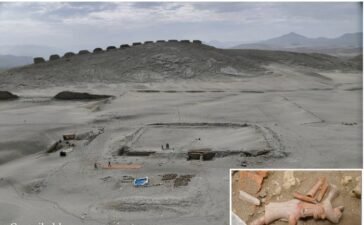Jan Bartek – AncientPages.com – Palmyra, renowned for its extraordinary heritage and archaeological remains, is one of Syria’s most famous sites. It was inscribed on the World Heritage List in 1980. Unfortunately, much of its heritage suffered destruction during the war. After Syria’s liberation from the Assad regime on December 8th, a multidisciplinary team conducted a field study in Palmyra to evaluate the current state of its archaeological monuments and surrounding residential areas.
Cella of the Temple of Bel (destroyed in 2015). Credit: Bernard Gagnon – CC BY-SA 3.0
This assessment compared their present condition with that before the Syrian uprising began in 2011. The report is an initiative by Palmyrene Voices of the NGO Heritage for Peace, in collaboration with CSIC’s Milà i Fontanals Institution.
‘We want,’ says Isber Sabrine, a CSIC archaeologist and one of the report’s coordinators, ’to raise awareness among both local communities and the international community about the serious threats facing Palmyra’s heritage’.
Sabrine, an archaeologist with Syrian roots, is currently conducting research at IMF-CSIC. The report was coordinated by Hasan Ali and Mohammed Fares, who are also archaeologists and part of the Palmyrene Voices initiative. A diverse team of 15 observers contributed to the data collection for this report. This team included citizens from Palmyra, archaeologists, and refugees who have recently returned to the city.
80% Of The City Destroyed Or On The Verge Of Collapse
The report provides an in-depth analysis of both historical and contemporary challenges faced by the region, particularly under the leadership of Hafez al-Assad (1971-2000) and Bashar al-Assad (2000-2024), as well as during the occupation by ISIS. It documents approximately 12 square kilometers of buildings and archaeological remains, including the Efqa Oasis. This area, spanning about 400 hectares, was completely destroyed in fires set by the Assad regime in 2020. Many trees have since dried out due to a lack of water supply, though some returning orchard owners are making efforts to revive their palm and olive trees.
The report further indicates that 80% of Palmyra’s buildings are either destroyed or at risk of collapse. The presence of landmines and scattered weapons poses additional dangers. Basic services such as water, electricity, internet access, education, and healthcare are severely lacking amidst widespread poverty affecting the population. Despite these conditions, approximately 10%—or around 10,000 people—of Palmyra’s original population have returned to their homes.
Damage To Archaeological Heritage
Observers have reported significant damage to 12 key monuments and archaeological sites, including notable Roman remains. These include the Tetrapylon, a monumental square platform with four tightly grouped columns at each corner from the 2nd century, and the Roman theatre from the same period. Other affected sites are the Camp of Diocletian (3rd century), the Castle of Palmyra or Qalʿat Ibn Maʿn (13th century), the Valley of the Tombs (1st century), the Archaeological Museum of Palmyra, among others.
View of Palmyra with the Temple of Bel, Syria. Credit: Bernard Gagnon – CC BY-SA 3.0
For instance, explosions have destroyed all four structures of the Tetrapylon, reducing its columns to rubble without any documentation or numbering that could aid in reconstruction. The BaalShamin Temple, approximately 2,200 years old, has also been demolished.
At the Roman theatre site, researchers discovered evidence of façade collapse due to bombing and signs of illegal excavations. The Archaeological Museum has suffered severe damage; most heavy statues and funerary beds are smashed or broken due to aerial bombardment. Although non-operational now, guards from the Directorate of Antiquities and local volunteers protect it without support from new administration officials or administrative staff for supervision.
According to the report’s authors, the availability of more staff for heritage protection and conservation in Palmyra is directly linked to the return of its population. ‘The city currently faces significant challenges due to the devastation caused by the conflict, which has led to the massive displacement of its inhabitants.
Urgent Need To Rebuild
According to a press release, the report highlights the crucial steps needed for Palmyra to regain its vitality and human resources necessary for managing its heritage. It emphasizes that prioritizing the reconstruction of basic infrastructure and habitable areas is essential. Without adequate housing, essential services, and economic opportunities, the return of residents will be limited, hindering the availability of local professionals and workers for heritage conservation, as noted by Isber Sabrine.
See also: More Archaeology News
The report aims to inspire both local and international communities to acknowledge the threats facing Palmyra and recognize the urgent need to rehabilitate its archaeological site, oasis, and residential areas. It stresses the importance of implementing rehabilitation and reconstruction strategies for both the archaeological site and modern city of Palmyra to ensure conservation efforts are successful and facilitate the return of its people.
This collaborative effort underscores the commitment of IMF-CSIC alongside the Palmyra Voices Initiative in defending cultural heritage while contributing to Syria’s post-conflict reconstruction.
Written by Jan Bartek – AncientPages.com Staff Writer








